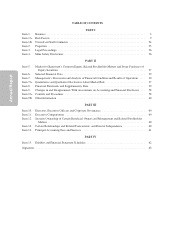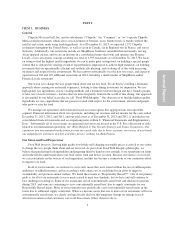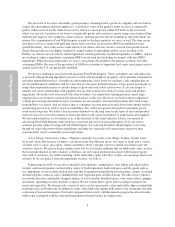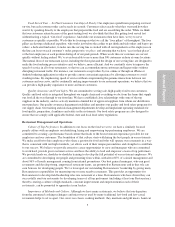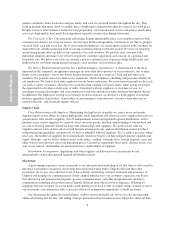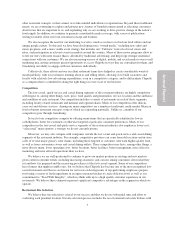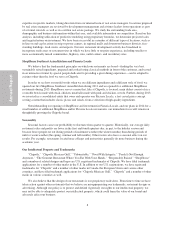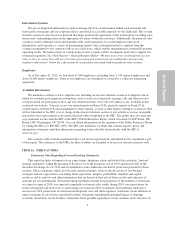Chipotle 2013 Annual Report Download - page 14
Download and view the complete annual report
Please find page 14 of the 2013 Chipotle annual report below. You can navigate through the pages in the report by either clicking on the pages listed below, or by using the keyword search tool below to find specific information within the annual report.
Our progress in opening new restaurants from quarter to quarter may also occur at an uneven rate, which
may result in quarterly sales and profit growth falling short of market expectations in some periods. Similarly,
our growth strategy and the substantial investment associated with the development of each new restaurant (as
well as the impact of our new restaurants on the sales of our existing restaurants) may cause our operating results
to fluctuate and be unpredictable or adversely affect our profits.
Our new restaurants, once opened, may not be profitable, and may adversely impact the sales of our
existing restaurants.
Historically, many of our new restaurants have opened with an initial ramp-up period typically lasting
24 months or more, during which they generated sales and income below the levels at which we expect them to
normalize. This is in part due to the time it takes to build a customer base in a new area, higher fixed costs
relating to increased labor and other start-up inefficiencies that are typical of new restaurants, and a larger
proportion of our recent openings being in higher rent sites than we have historically targeted. It may also be
difficult for us to attract a customer base if we are not able to staff our restaurants with employees who perform
to our high standards. If we are unable to build the customer base that we expect for new restaurant locations or
overcome the higher fixed costs associated with new restaurant locations, new restaurants may not have similar
results as our existing restaurants and may not be profitable. We also have lowered the average development
cost, net of landlord reimbursements, for new Chipotle restaurants in the U.S. significantly in recent years, from
about $916,000 in 2008 to about $800,000 in 2013. In 2014, we expect average development costs to increase
about 5%. In the event we are not able to achieve the average development costs we expect for 2014 or sustain
the benefits achieved in prior years, which could result from inflation, project mismanagement or other reasons,
our new restaurant locations could also result in decreased profitability. Additionally, our new restaurant
development activity has broadened recently to incorporate trade areas or restaurant sites in which we have little
or no prior experience, including smaller or more economically mixed communities, highway sites, outlet
centers, and restaurants in airports, food courts, or on military sites. The risks relating to building a customer base
and managing development and operating costs may be more significant in some or all of these types of trade
areas or restaurant sites.
In addition, we have now opened restaurants in nearly all major metropolitan areas across the U.S. New
restaurants opened in existing markets may adversely impact sales in previously-opened restaurants in the same
market as customers who frequent our established restaurants begin to visit a newly-opened restaurant instead.
This impact could worsen as we open additional restaurants, and could make it more difficult for us to increase
comparable restaurant sales and profitability. Existing restaurants could also make it more difficult to build the
customer base for newly-opened restaurants in the same market.
Our expansion into international markets may present increased risks due to lower customer awareness
of our brand, our unfamiliarity with those markets and other factors.
In 2008, we opened our first restaurant outside the U.S., in Toronto, Canada. In 2010 we opened our first
restaurant in the United Kingdom in London, in 2012 we opened our first restaurant in France in Paris, and in
2013 we opened our first restaurant in Germany in Frankfurt. As of December 31, 2013, 16 of our restaurants
were located outside of the U.S. As a result of our small number of restaurants outside the U.S. and the relatively
short time we have been operating those restaurants, we have lower brand awareness, lower sales and/or
transaction counts, and less operating experience in these markets. The markets in which we’ve opened
restaurants outside the U.S., and any additional new markets we enter outside the U.S. in the future, have
different competitive conditions, consumer tastes and discretionary spending patterns than our U.S. markets. As a
result, new restaurants outside the U.S. may be less successful than restaurants in our existing markets.
Specifically, due to lower consumer familiarity with the Chipotle brand, differences in customer tastes or
spending patterns, or for other reasons, sales at restaurants opened outside the U.S. may take longer to ramp up
and reach expected sales and profit levels, and may never do so, thereby affecting our overall profitability. To
build brand awareness in international markets, we may need to make greater investments in advertising and
promotional activity than we originally planned, which could negatively impact the profitability of our operations
in those markets.
12
Annual Report


